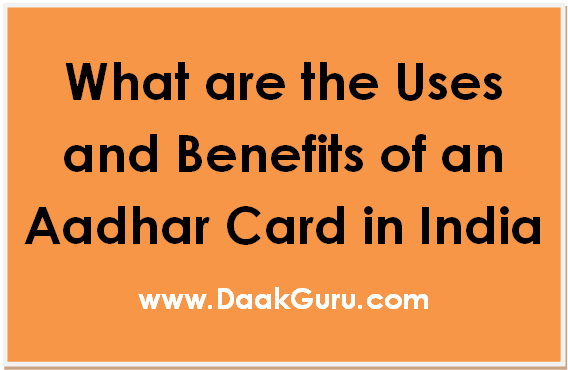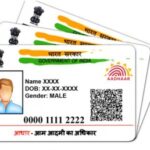An Aadhaar card is a 12-digit unique identification number issued by the Unique Identification Authority of India (UIDAI), a government agency in India. The primary use of Aadhaar cards is to establish the identity of Indian residents and provide a means of verifying their identity for various government and private-sector services.
Here are some of the key uses of Aadhaar cards:
- Identity Verification: Aadhaar cards serve as a valid proof of identity for individuals in India. It contains biometric and demographic information, including a photograph, fingerprints, and iris scans, making it a robust means of verifying a person’s identity.
- Access to Government Services: Aadhaar is often required for accessing various government services and subsidies, such as the distribution of food grains through the Public Distribution System (PDS), direct benefit transfers (DBT), and government welfare programs.
- Financial Services: Aadhaar is linked to bank accounts, and it is often used for various financial transactions and services, including opening bank accounts, receiving government subsidies and pensions, and conducting electronic Know Your Customer (e-KYC) processes for financial institutions.
- Mobile Services: Aadhaar is used for mobile number verification through the e-KYC process, ensuring that mobile connections are linked to legitimate individuals.
- Taxation: Aadhaar may be used for filing income tax returns and linking with Permanent Account Numbers (PAN), which helps in curbing tax evasion and ensuring that individuals pay their taxes.
- Travel and Passport Services: Aadhaar can be used as a proof of identity and address when applying for a passport or other travel-related documents.
- Digital Signatures: Aadhaar can be used to create digital signatures for online transactions and document authentication.
- Education and Scholarships: Aadhaar is often required for enrollment in educational institutions and for applying for government scholarships.
- Pension and Social Security: It is used for availing of pension and social security benefits.
- Property Transactions: Aadhaar can be used for property-related transactions, such as land acquisition and property registration.
- Insurance: It is used for purchasing and availing of insurance policies.
- Subsidies and Schemes: Various government subsidies and schemes are linked to Aadhaar to ensure that benefits reach the intended beneficiaries efficiently and reduce fraudulent claims.
It’s important to note that while Aadhaar has many important uses, concerns have been raised about privacy and security issues, and there have been legal and regulatory developments to address these concerns. As of my last knowledge update in September 2021, the Indian government was continuously refining the Aadhaar ecosystem and addressing privacy and security issues through legislation and court rulings. Therefore, it’s advisable to check the latest regulations and guidelines related to Aadhaar if you have specific questions or concerns. An Aadhaar card is a unique identification card issued by the Unique Identification Authority of India (UIDAI) to residents of India. Aadhaar is a 12-digit alphanumeric number that serves as proof of identity and address for Indian citizens.
The primary uses of Aadhaar cards include:
- Identity Verification: Aadhaar cards are widely used as a valid proof of identity for various purposes, such as opening bank accounts, applying for government services and subsidies, getting a mobile phone connection, and more.
- Financial Services: Aadhaar is linked to various financial services in India, including the Direct Benefit Transfer (DBT) system, which ensures that government subsidies and welfare benefits are directly deposited into the bank accounts of eligible beneficiaries.
- Tax Filing: Aadhaar is required for filing income tax returns in India, making it an essential document for taxpayers.
- Government Services: Aadhaar is used to access various government services and schemes, such as the Pradhan Mantri Jan Dhan Yojana (financial inclusion program), LPG subsidy, and more.
- Mobile SIM Cards: Aadhaar is used for identity verification when applying for a mobile phone SIM card, as per the government’s regulations.
- Passport and Visa: Aadhaar can also be used as a supporting document when applying for a passport or visa.
- Digital Identity: Aadhaar enables the creation of a digital identity for individuals, which can be used for online authentication and eKYC (electronic Know Your Customer) processes.
- Pension and Provident Fund: Aadhaar is linked to pension schemes and provident fund accounts to facilitate disbursements and withdrawals.
- Healthcare Services: Aadhaar can be used for authentication when accessing healthcare services and benefits, such as the Ayushman Bharat health insurance scheme.
- Education: Aadhaar may be required for admission to educational institutions and for various scholarship schemes.
It’s important to note that while Aadhaar has many uses, there have been debates and concerns about privacy and data security associated with the Aadhaar system. The Indian government has taken steps to address these concerns and enhance the security of Aadhaar data. Aadhaar is a 12-digit unique identification number issued by the Unique Identification Authority of India (UIDAI), which is a statutory authority established by the Government of India.
Aadhaar cards serve several purposes in India:
- Identity Proof: Aadhaar serves as a valid proof of identity for Indian residents. It contains demographic and biometric information, including a photograph, fingerprint, and iris scan, making it a secure means of identification.
- Address Proof: Aadhaar cards also include the address of the cardholder, making them a valid proof of address for various purposes like opening bank accounts, applying for government services, and more.
- Direct Benefit Transfers (DBT): The government of India uses Aadhaar as a means to transfer subsidies and benefits directly to the bank accounts of eligible beneficiaries. This helps in reducing leakages and ensuring that benefits reach the intended recipients.
- Financial Services: Aadhaar is linked to many financial services, including opening bank accounts, obtaining loans, and investing in financial instruments. It simplifies the Know Your Customer (KYC) process for financial institutions.
- Mobile SIM Card Verification: Aadhaar is used for verifying the identity of individuals applying for mobile phone SIM cards, enhancing security and reducing fraud.
- Digital Signatures: Aadhaar provides a platform for digitally signing documents, making it useful for various online transactions and e-governance services.
- Government Subsidies: It is often required for individuals to link their Aadhaar numbers with various government schemes and subsidies to receive benefits and entitlements.
- PAN Card Linkage: The Indian government has mandated the linkage of Aadhaar with Permanent Account Numbers (PAN) for income tax purposes.
- Travel Document: Aadhaar can be used as a valid identity document for domestic air travel within India.
- E-Governance: Many government services and initiatives are linked to Aadhaar to streamline processes, reduce fraud, and improve transparency in governance.
It’s important to note that while Aadhaar has various uses and benefits, concerns have been raised about privacy and data security. The government has taken measures to address these concerns and enhance the security of Aadhaar data. Additionally, the use and linkage of Aadhaar for various purposes may evolve over time, so it’s essential to stay updated on its current applications and requirements.
भारत में आधार कार्ड के उपयोग और लाभ क्या हैं?
आधार कार्ड भारत की एक सरकारी एजेंसी, भारतीय विशिष्ट पहचान प्राधिकरण (यूआईडीएआई) द्वारा जारी की गई 12 अंकों की विशिष्ट पहचान संख्या है। आधार कार्ड का प्राथमिक उपयोग भारतीय निवासियों की पहचान स्थापित करना और विभिन्न सरकारी और निजी क्षेत्र की सेवाओं के लिए उनकी पहचान सत्यापित करने का साधन प्रदान करना है।
यहां आधार कार्ड के कुछ प्रमुख उपयोग दिए गए हैं:
- पहचान सत्यापन: आधार कार्ड भारत में व्यक्तियों के लिए पहचान के वैध प्रमाण के रूप में काम करता है। इसमें बायोमेट्रिक और जनसांख्यिकीय जानकारी शामिल है, जिसमें एक तस्वीर, उंगलियों के निशान और आईरिस स्कैन शामिल हैं, जो इसे किसी व्यक्ति की पहचान सत्यापित करने का एक मजबूत साधन बनाता है।
- सरकारी सेवाओं तक पहुंच: विभिन्न सरकारी सेवाओं और सब्सिडी तक पहुंचने के लिए अक्सर आधार की आवश्यकता होती है, जैसे सार्वजनिक वितरण प्रणाली (पीडीएस), प्रत्यक्ष लाभ हस्तांतरण (डीबीटी), और सरकारी कल्याण कार्यक्रमों के माध्यम से खाद्यान्न का वितरण।
- वित्तीय सेवाएँ: आधार बैंक खातों से जुड़ा हुआ है, और इसका उपयोग अक्सर विभिन्न वित्तीय लेनदेन और सेवाओं के लिए किया जाता है, जिसमें बैंक खाते खोलना, सरकारी सब्सिडी और पेंशन प्राप्त करना और वित्तीय संस्थानों के लिए इलेक्ट्रॉनिक नो योर कस्टमर (ई-केवाईसी) प्रक्रियाओं का संचालन करना शामिल है।
- मोबाइल सेवाएँ: आधार का उपयोग ई-केवाईसी प्रक्रिया के माध्यम से मोबाइल नंबर सत्यापन के लिए किया जाता है, जिससे यह सुनिश्चित होता है कि मोबाइल कनेक्शन वैध व्यक्तियों से जुड़े हुए हैं।
- कराधान: आधार का उपयोग आयकर रिटर्न दाखिल करने और स्थायी खाता संख्या (पैन) से जोड़ने के लिए किया जा सकता है, जो कर चोरी को रोकने और यह सुनिश्चित करने में मदद करता है कि व्यक्ति अपने करों का भुगतान करें।
- यात्रा और पासपोर्ट सेवाएँ: पासपोर्ट या अन्य यात्रा-संबंधित दस्तावेजों के लिए आवेदन करते समय आधार का उपयोग पहचान और पते के प्रमाण के रूप में किया जा सकता है।
- डिजिटल हस्ताक्षर: आधार का उपयोग ऑनलाइन लेनदेन और दस्तावेज़ प्रमाणीकरण के लिए डिजिटल हस्ताक्षर बनाने के लिए किया जा सकता है।
- शिक्षा और छात्रवृत्ति: शैक्षणिक संस्थानों में नामांकन और सरकारी छात्रवृत्ति के लिए आवेदन करने के लिए अक्सर आधार की आवश्यकता होती है।
- पेंशन और सामाजिक सुरक्षा: इसका उपयोग पेंशन और सामाजिक सुरक्षा लाभ प्राप्त करने के लिए किया जाता है।
- संपत्ति लेनदेन: आधार का उपयोग संपत्ति से संबंधित लेनदेन, जैसे भूमि अधिग्रहण और संपत्ति पंजीकरण के लिए किया जा सकता है।
- बीमा: इसका उपयोग बीमा पॉलिसियों को खरीदने और उनका लाभ उठाने के लिए किया जाता है।
- सब्सिडी और योजनाएं: विभिन्न सरकारी सब्सिडी और योजनाएं आधार से जुड़ी हुई हैं ताकि यह सुनिश्चित किया जा सके कि लाभ इच्छित लाभार्थियों तक कुशलतापूर्वक पहुंचे और धोखाधड़ी वाले दावों को कम किया जा सके।
यह ध्यान रखना महत्वपूर्ण है कि हालांकि आधार के कई महत्वपूर्ण उपयोग हैं, गोपनीयता और सुरक्षा के मुद्दों के बारे में चिंताएं उठाई गई हैं, और इन चिंताओं को दूर करने के लिए कानूनी और नियामक विकास हुए हैं। सितंबर 2021 में मेरे अंतिम ज्ञान अद्यतन के अनुसार, भारत सरकार लगातार आधार पारिस्थितिकी तंत्र को परिष्कृत कर रही थी और कानून और अदालती फैसलों के माध्यम से गोपनीयता और सुरक्षा मुद्दों को संबोधित कर रही थी। इसलिए, यदि आपके पास विशिष्ट प्रश्न या चिंताएं हैं तो आधार से संबंधित नवीनतम नियमों और दिशानिर्देशों की जांच करना उचित है। आधार कार्ड भारतीय विशिष्ट पहचान प्राधिकरण (यूआईडीएआई) द्वारा भारत के निवासियों को जारी किया जाने वाला एक विशिष्ट पहचान पत्र है। आधार एक 12 अंकों का अल्फ़ान्यूमेरिक नंबर है जो भारतीय नागरिकों के लिए पहचान और पते के प्रमाण के रूप में कार्य करता है।
आधार कार्ड के प्राथमिक उपयोगों में शामिल हैं:
- पहचान सत्यापन: आधार कार्ड का व्यापक रूप से विभिन्न उद्देश्यों के लिए पहचान के वैध प्रमाण के रूप में उपयोग किया जाता है, जैसे बैंक खाते खोलना, सरकारी सेवाओं और सब्सिडी के लिए आवेदन करना, मोबाइल फोन कनेक्शन प्राप्त करना, और बहुत कुछ।
- वित्तीय सेवाएँ: आधार भारत में विभिन्न वित्तीय सेवाओं से जुड़ा हुआ है, जिसमें प्रत्यक्ष लाभ अंतरण (डीबीटी) प्रणाली भी शामिल है, जो यह सुनिश्चित करती है कि सरकारी सब्सिडी और कल्याण लाभ सीधे पात्र लाभार्थियों के बैंक खातों में जमा किए जाते हैं।
- टैक्स फाइलिंग: भारत में आयकर रिटर्न दाखिल करने के लिए आधार की आवश्यकता होती है, जिससे यह करदाताओं के लिए एक आवश्यक दस्तावेज बन जाता है।
- सरकारी सेवाएँ: आधार का उपयोग विभिन्न सरकारी सेवाओं और योजनाओं तक पहुँचने के लिए किया जाता है, जैसे कि प्रधान मंत्री जन धन योजना (वित्तीय समावेशन कार्यक्रम), एलपीजी सब्सिडी, और बहुत कुछ।
- मोबाइल सिम कार्ड: सरकार के नियमों के अनुसार, मोबाइल फोन सिम कार्ड के लिए आवेदन करते समय पहचान सत्यापन के लिए आधार का उपयोग किया जाता है।
- पासपोर्ट और वीज़ा: पासपोर्ट या वीज़ा के लिए आवेदन करते समय आधार का उपयोग सहायक दस्तावेज़ के रूप में भी किया जा सकता है।
- डिजिटल पहचान: आधार व्यक्तियों के लिए एक डिजिटल पहचान बनाने में सक्षम बनाता है, जिसका उपयोग ऑनलाइन प्रमाणीकरण और ईकेवाईसी (इलेक्ट्रॉनिक नो योर कस्टमर) प्रक्रियाओं के लिए किया जा सकता है।
- पेंशन और भविष्य निधि: संवितरण और निकासी की सुविधा के लिए आधार को पेंशन योजनाओं और भविष्य निधि खातों से जोड़ा गया है।
- स्वास्थ्य सेवाएँ: आयुष्मान भारत स्वास्थ्य बीमा योजना जैसी स्वास्थ्य सेवाओं और लाभों तक पहुँचने के लिए आधार का उपयोग प्रमाणीकरण के लिए किया जा सकता है।
- शिक्षा: शैक्षणिक संस्थानों में प्रवेश और विभिन्न छात्रवृत्ति योजनाओं के लिए आधार की आवश्यकता हो सकती है।
यह ध्यान रखना महत्वपूर्ण है कि हालांकि आधार के कई उपयोग हैं, आधार प्रणाली से जुड़ी गोपनीयता और डेटा सुरक्षा के बारे में बहस और चिंताएं रही हैं। भारत सरकार ने इन चिंताओं को दूर करने और आधार डेटा की सुरक्षा बढ़ाने के लिए कदम उठाए हैं। आधार भारतीय विशिष्ट पहचान प्राधिकरण (यूआईडीएआई) द्वारा जारी एक 12 अंकों की विशिष्ट पहचान संख्या है, जो भारत सरकार द्वारा स्थापित एक वैधानिक प्राधिकरण है।
आधार कार्ड भारत में कई उद्देश्यों की पूर्ति करता है:
- पहचान प्रमाण: आधार भारतीय निवासियों के लिए पहचान के वैध प्रमाण के रूप में कार्य करता है। इसमें जनसांख्यिकीय और बायोमेट्रिक जानकारी शामिल है, जिसमें एक तस्वीर, फिंगरप्रिंट और आईरिस स्कैन शामिल है, जो इसे पहचान का एक सुरक्षित साधन बनाता है।
- पते का प्रमाण: आधार कार्ड में कार्डधारक का पता भी शामिल होता है, जो उन्हें बैंक खाते खोलने, सरकारी सेवाओं के लिए आवेदन करने आदि जैसे विभिन्न उद्देश्यों के लिए पते का वैध प्रमाण बनाता है।
- प्रत्यक्ष लाभ अंतरण (डीबीटी): भारत सरकार पात्र लाभार्थियों के बैंक खातों में सीधे सब्सिडी और लाभ हस्तांतरित करने के साधन के रूप में आधार का उपयोग करती है। इससे लीकेज को कम करने और यह सुनिश्चित करने में मदद मिलती है कि लाभ इच्छित प्राप्तकर्ताओं तक पहुंचे।
- वित्तीय सेवाएँ: आधार कई वित्तीय सेवाओं से जुड़ा हुआ है, जिसमें बैंक खाते खोलना, ऋण प्राप्त करना और वित्तीय साधनों में निवेश करना शामिल है। यह वित्तीय संस्थानों के लिए अपने ग्राहक को जानें (केवाईसी) प्रक्रिया को सरल बनाता है।
- मोबाइल सिम कार्ड सत्यापन: आधार का उपयोग मोबाइल फोन सिम कार्ड के लिए आवेदन करने वाले व्यक्तियों की पहचान सत्यापित करने, सुरक्षा बढ़ाने और धोखाधड़ी को कम करने के लिए किया जाता है।
- डिजिटल हस्ताक्षर: आधार दस्तावेजों पर डिजिटल रूप से हस्ताक्षर करने के लिए एक मंच प्रदान करता है, जो इसे विभिन्न ऑनलाइन लेनदेन और ई-गवर्नेंस सेवाओं के लिए उपयोगी बनाता है।
- सरकारी सब्सिडी: लाभ और अधिकार प्राप्त करने के लिए व्यक्तियों को अक्सर विभिन्न सरकारी योजनाओं और सब्सिडी के साथ अपने आधार नंबर को जोड़ना आवश्यक होता है।
- पैन कार्ड लिंकेज: भारत सरकार ने आयकर उद्देश्यों के लिए आधार को स्थायी खाता संख्या (पैन) के साथ जोड़ना अनिवार्य कर दिया है।
- यात्रा दस्तावेज़: आधार का उपयोग भारत के भीतर घरेलू हवाई यात्रा के लिए वैध पहचान दस्तावेज़ के रूप में किया जा सकता है।
- ई-गवर्नेंस: प्रक्रियाओं को सुव्यवस्थित करने, धोखाधड़ी को कम करने और शासन में पारदर्शिता में सुधार के लिए कई सरकारी सेवाओं और पहलों को आधार से जोड़ा गया है।
यह ध्यान रखना महत्वपूर्ण है कि हालांकि आधार के विभिन्न उपयोग और लाभ हैं, गोपनीयता और डेटा सुरक्षा के बारे में चिंताएं उठाई गई हैं। सरकार ने इन चिंताओं को दूर करने और आधार डेटा की सुरक्षा बढ़ाने के लिए कदम उठाए हैं। इसके अतिरिक्त, विभिन्न उद्देश्यों के लिए आधार का उपयोग और लिंकेज समय के साथ विकसित हो सकता है, इसलिए इसके वर्तमान अनुप्रयोगों और आवश्यकताओं पर अपडेट रहना आवश्यक है।


